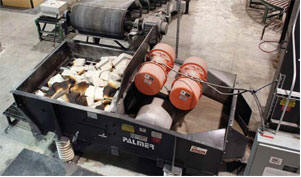Foundry & industrial processing Machinery EQUIPMENT & SYSTEMS
U.S. & Canada Call 1.800.457.5456
Considerations for Reclaiming Chemically Bonded Sand
Home Articles Considerations for Reclaiming Chemically Bonded Sand

Foundry Management & Technology Magazine, January 23, 2012 issue.
Written - Jack Palmer.
Reprinted by permission of Penton Media, Inc.
While the initial investment may seem onerous, justification is usually fast enough to meet even the most aggressive ROI requirements.

The factors that justify sand reclamation are changing, and redefining the planning process.
Reclamation and reuse of foundry sands has always made economical and environmental sense, however the recent demands placed on sand by the oil and gas industries has made sand reclamation a process that no foundry can afford to overlook. While the initial investment may appear onerous, justification is usually fast enough to meet even the most aggressive ROI requirements. There are also new technologies available to accommodate all foundries, from the large-volume production foundry to the shop that does small runs, and even those that produce one-of-something, etc.
Determining ROI - A very simple spreadsheet analysis can determine ROI. It is essential to include all of costs: freight of sand both incoming and for disposal, cost of new sand, storage, and additional handling for disposal, and disposal fees. Also, make sure you understand how much sand you will be processing versus disposing. The amount of sand used is usually defined as the amount to keep the LOI (loss on ignition) percentage at an acceptable level. After totaling all of these costs, it becomes obvious that it doesn’t take a very large operation to justify at least a good mechanical sand reclamation system.
Disposal costs - Of the big three costs (sand, shipping, and disposal) the cost of disposal is the great unknown. Disposal costs can double, triple, or even rise tenfold with one phone call. There have even been cases where foundry sand that had been desirable for use as landfill cover gets reclassified as hazardous waste, with a huge increase in dumping fees, and still be used for the same purpose.
Justification - Reclamation system justification must include all costs: engineering the project, shipping equipment to the site, site prep, installation, commissioning, floor space, daily operating costs, annual maintenance costs, and capital costs, etc. Careful consideration obviously needs to be given to the equipment to reclaim the sand to a cooled, screened, reusable state but attention also must be given to the overall system process and how it integrates into the plant as a whole.
Reclamation planning - No reclamation system should be designed for current requirements and throughputs. If financial restraints requires equipment to meet only current needs, the system should be designed to be as easy and inexpensive as possible to expand in the future, because many shops experience a gradual increase in mold size and (hopefully) mold production.
Among the decisions that must be made when planning to install sand reclamation capability:
- Location: What will be the system’s proximity to incoming molds, and point of reuse?
- Usage: Will the system be designed for single- or multiple-shift operation? The likelihood of material surges is a consideration, too: what will be the rate of throughput?
- Storage silo/day bin capacities: The size and location of all storage devices need to be carefully considered. A general rule is two to four hours usage above the mixer, with a bulk silo able to hold all the mechanically reclaimed sand from all the molds on the floor or in a system. Obviously, these sizes vary depending on several factors, but it is good to get the largest silo that is reasonable. As the size of a silo increases, the cost per ton of available capacity decreases quickly.
- Thermal reclamation: Will this function be part of the initial system? If not, where will it be installed/configured later?
- Blending: Reclaimed sand (mechanical and thermal) needs to be returned to the system in a controlled manner to eliminate variables, but at acceptable LOI levels. New sand additions (not the same as thermally reclaimed sand) also need to be consistent and controlled.
- Maintenance accessibility.
Reclamation equipment - Current reclamation equipment technology also needs to be researched to determine the optimal design to fit a given requirement. Recent developments in vibratory and rotary mechanical attrition, low-level combination decks, shakeout decks with no holes to damage castings, and a number of gas and electric thermal reclamation concepts need to be thoroughly investigated.
Thermal sand reclamation - Most no-bake shops have some form of mechanical reclamation; however, frac technology developments require that current systems be analyzed for adding thermal reclamation. It is very common for a foundry to outgrow equipment, but this process is usually so gradual and not noticeable until it becomes financially obvious. Nowhere is this truer than in no-bake shops where the tendency is for work to get larger. Mold size increases in a green sand facility usually take a large financial investment in sand processing equipment, skill levels, etc., but in no-bake foundries it is fairly straightforward to make a larger mold as long as it can be handled.
Thermal reclamation equipment is comparatively expensive but can make economic sense at a certain level of sand usage. This tonnage level is obviously different in every case but it is trending downward. Justifying thermal sand reclamation is different than justifying mechanical reclamation, because there are intangibles or unknowns that are difficult to quantify, depending on sand type, binder system, etc.
One of the main foundry advantages of thermally reclaimed sand is that it helps lessen expansion defects. This is especially critical for cast surfaces with impellors, volutes, etc. It is not uncommon for foundries to run all new sand through the thermal system for this reason. Thermally reclaimed sand also require may substantially less binder to achieve acceptable strengths, compared to new sand.
Jack Palmer is the president of Palmer Manufacturing & Supply, Inc., Springfield, OH. Visit www.palmermfg.com for more information.
Copyright © 2024 Palmer Manufacturing & Supply, Inc. | Terms and Conditions | Privacy Policy
Web published by Marketing Options, LLC.




